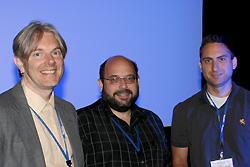News Story
Metting and Hsieh Take 2nd, 3rd in ACNS Poster Competition

Chris Metting receives 2nd prize at the ACNS student poster competition. Left to right: Professor Simon Billinge (Columbia University), Vice President of the Neutron Scattering Society of America; Dr. Ken Herwig (Oak Ridge National Lab), chair of the prize selection committee; and MSE graduate student Chris Metting.
ACNS highlights the latest research in neutron science, including work in the areas of soft and hard condensed matter, liquids, biology, magnetism, spectroscopy, crystal structure, physics, and instrumentation.
Metting's poster, "Characterization and modeling of off-specular neutron scattering for analysis of two dimensional ordered structures," demonstrated advances in the use of off-specular neutron reflectometry as a materials characterization technique. Off-specular neutron reflectometry is not widely used in materials and other research due to the lack of a complete, user friendly, broadly-distributed modeling software package. Metting, Briber, and their colleagues at the NIST's Center for Neutron Research (NCNR) and the National Science Foundation-funded Data Analysis for Neutron Scattering Experiments (DANSE) project, are developing a software component for fitting multilayer two dimensionally-structured samples, a tool that could make off-specular neutron reflectometry accessible to a broader scientific community. Metting's presentation discussed the team's progress in the modeling of data.
Hsieh's poster, titled "The gas adsorption behaviors in chiral holmium metal-organic framework materials," described a reliable method of condensing hydrogen for use in fuel cell technology, a key issue that must be addressed in order to make it viable on a commercial scale. Hsieh and his colleagues at NIST have been working on ways to improve the performance of metal-organic frameworks (MOF), high surface-area, porous materials that are used as "hydrogen sponges" capable of trapping and storing hydrogen at higher densities. In their study, different dimensional MOF crystal structures were successfully synthesized, and a series of high resolution powder neutron diffractions were performed to identify the adsorption positions in the 3-D MOF network. The results showed the "optimal" pore size constructed by a carbon-based organic ligand can dramatically enhance the MOF's H2 adsorption capacity, resulting in extremely high packing densities. A unique "helical hydrogen" adsorption trajectory was also observed in this 4-fold chiral crystal system, implying a prominent influence from its noncentrosymmetric architecture.
For More Information:
Published July 7, 2010









